Publications - Selected Papers
Artificial ‘spin ice’ in a geometrically frustrated lattice of nanoscale ferromagnetic islands. Nature.
In this seminal paper we engineered geometrically frustrated lattices composed of nanoscale ferromagnetic islands creating what we called artificial Spin Ices. This approach allowed us to unlock the secrets of magnetic frustration in a controlled and precise manner, marking the beginning of a new exciting area of research. Our work has revealed intriguing emergent phenomena, later associated with the creation of quasi-particles resembling magnetic monopoles - entities that have long eluded discovery in nature. These findings have captivated the scientific community and fueled intense exploration of artificial frustrated systems and their implications for condensed matter physics.
Nature 439, pages 303–306 (2006)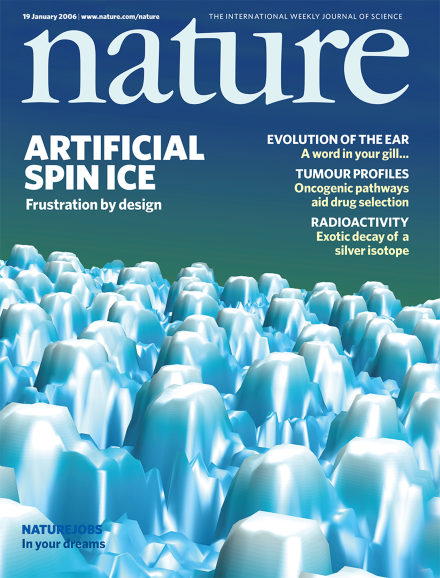
Zero-point entropy in stuffed spin-ice. Nature Physics.
The third law of thermodynamics dictates that the entropy of a system in thermal equilibrium goes to zero as its temperature approaches absolute zero. In ice, however, a ‘zero point’ or residual entropy can be measured—attributable to a high degeneracy in the energetically preferred positions of hydrogen ions associated with the so-called ‘ice rules’. Remarkably, the spins in certain magnetic materials with the pyrochlore structure of corner-sharing tetrahedra, called ‘spin ice’, have an equivalent degeneracy of energetically preferred states, and also have a zero-point entropy. Here, we chemically alter Ho2Ti2O7 spin ice by ‘stuffing’ extra Ho magnetic moments into otherwise non-magnetic Ti sites surrounding the Ho tetrahedra. The resulting series, Ho2(Ti2−xHox)O7−x/2, provides a unique opportunity to study the effects of increased connectivity between spins on a frustrated lattice. Surprisingly, the zero-point entropy per spin measured appears unchanged by these excess spins. The results suggest a chemical approach for studying ice-like frustration and other properties of the broad family of geometrically frustrated magnets based on the pyrochlore structure.
Nature Physics 2, pages 249–253 (2006)
Nonmonotonic zero-point entropy in diluted spin ice. Physical Review Letters.
Water ice and spin ice are important model systems in which theory can directly account for “zero-point” entropy associated with quenched configurational disorder. Spin ice differs from water ice in the important respect that its fundamental constituents, the spins of the magnetic ions, can be removed through replacement with nonmagnetic ions while keeping the lattice structure intact. In order to investigate the interplay of frustrated interactions and quenched disorder, we have performed systematic heat capacity measurements on spin ice materials which have been thus diluted up to 90%. Investigations of both Ho and Dy spin ices reveal that the zero-point entropy depends nonmonotonically on dilution and approaches the value of R ln 2 in the limit of high dilution. The data are in good agreement with a generalization of Pauling’s theory for the entropy of ice.
Phys. Rev. Lett. 99, 137203 (2007)
Magnetic tuning of all-organic binary alloys between two stable radicals. Journal of the American Chemical Society.
Mixtures of 2-(4,5,6,7-tetrafluorobenzimidazol-2-yl)-4,4,5,5-tetramethyl-4,5-dihydro-1H-imidazole-3-oxide-1-oxyl (F4BImNN) and 2-(benzimidazol-2-yl)-4,4,5,5-tetramethyl-4,5-dihydro-1H-imidazole-3-oxide-1-oxyl (BImNN) crystallize as solid solutions (alloys) across a wide range of binary compositions. (F4BImNN)x(BImNN)(1–x) with x < 0.8 gives orthorhombic unit cells, while x ≥ 0.9 gives monoclinic unit cells. In all crystalline samples, the dominant intermolecular packing is controlled by one-dimensional (1D) hydrogen-bonded chains that lead to quasi-1D ferromagnetic behavior. Magnetic analysis over 0.4–300 K indicates ordering with strong 1D ferromagnetic exchange along the chains (J/k = 12–22 K). Interchain exchange is estimated to be 33- to 150-fold weaker, based on antiferromagnetic ordered phase formation below Néel temperatures in the 0.4–1.2 K range for the various compositions. The ordering temperatures of the orthorhombic samples increase linearly as (1 – x) increases from 0.25 to 1.00. The variation is attributed to increased interchain distance corresponding to decreased interchain exchange, when more F4BImNN is added into the orthorhombic lattice. The monoclinic samples are not part of the same trend, due to the different interchain arrangement associated with the phase change.
J. Am. Chem. Soc. 134, 8, 3825–3833 (2012)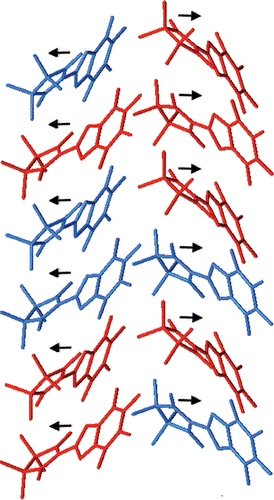
Magnetic relaxation phenomena and cluster glass properties of La0.7−xYxCa0.3MnO3 manganites. Physical Review B.
The dynamic magnetic properties of the distorted perovskite system La0.7−xYxCa0.3MnO3 (0<x<0.15) have been investigated by ac susceptibility and dc magnetization measurements, including relaxation and aging studies. All investigated samples display a metal-insulator transition. As yttrium is added in the compounds the overall results show evidence for the gradual appearance of a cluster glass behavior. For the x=0.15 sample, magnetization measurements as a function of time at various temperatures show that the magnetic relaxation is maximum at a given temperature, well below the ferromagnetic transition. This maximum coincides in temperature with a frequency-dependent feature in the imaginary part of the ac susceptibility, associated with a freezing process. This is interpreted as due to ferromagnetic clusters, which grow with decreasing temperature down to a temperature at which they freeze due to severe intercluster frustration.
Phys. Rev. B 64, 144404 (2001)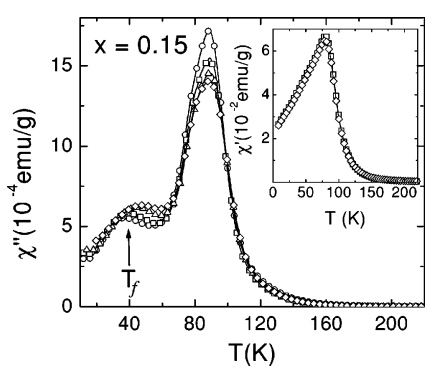
Publications - Most Recent*
Glassy correlated state induced by disorder in the frustrated antiferromagnet Tb2Zr2O7. Journal of Magnetism and Magnetic Materials.
We study the low-temperature thermomagnetic properties of the polycrystalline material Tb2Zr2O7 through ac susceptibility and specific heat measurements. This zirconate displays a defect-fluorite structure in which the magnetic Tb3+ and nonmagnetic Zr4+ cations sit randomly on the same metal sublattice. No long-range magnetic order is found down to 100 mK, although dominant antiferromagnetic interactions are observed and the spins remain dynamic down to the lowest temperatures investigated. We observed a frequency-dependent peak around 2.5 K which is well described by many models of a canonical spin-glass transition. In-field specific heat measurements and the recovered entropy of the system Rln(4) suggest a two doublets ground state separated by 7 K. Comparisons to the pyrochlores Tb2Ti2O7 and Tb2Hf2O7 reinforce the collective spin-glass-type behavior and the opening for discussions of an exotic Coulomb phase in this material.
JMMM 565, 170215 (2023)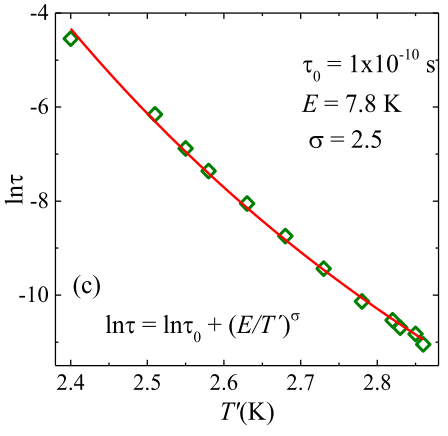
Antiferromagnetism and magnetic frustration in the metalorganic compounds MCl2-4SC(NH2)2, M = (Mn,Fe). Physical Review B.
We report magnetic and specific heat measurements at low temperatures (< 100 mK) and high magnetic fields (up to 9 T) for the metalorganic compounds MnCl2-4SC(NH2)2 (DTM) and FeCl2-4SC(NH2)2 (DTF). Fits to the experimental data from the Curie-Weiss law and mean-field theory indicate the antiferromagnetic nature of both compounds. For temperatures down to T=0.56 K the compound DTM exhibits two successive transitions, which may be associated with different magnetic orderings. In this system the external magnetic field is a tuning parameter that allows us to access such magnetic phases separated by distinct quantum critical points. No indication of magnetic ordering is found in DTF down to 100 mK, making this compound a candidate for a strongly frustrated material with frustration parameter f=|θCW|/TN> 100. Finally, we discuss the absence of Bose-Einstein condensation of magnons and the possibility of a spin-orbital liquid state in DTF.
Phys. Rev. B 105, 134405 (2022)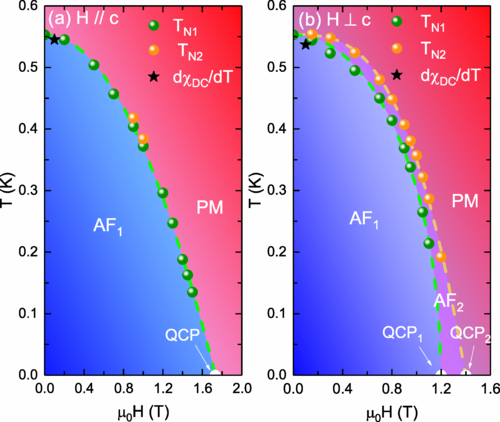
Magnetic field induced quantum spin liquid in the two coupled trillium lattices of K2Ni2(SO4)3. Physical Review Letters.
Quantum spin liquids are exotic states of matter that form when strongly frustrated magnetic interactions induce a highly entangled quantum paramagnet far below the energy scale of the magnetic interactions. Three-dimensional cases are especially challenging due to the significant reduction of the influence of quantum fluctuations. Here, we report the magnetic characterization of K2Ni2(SO4)3 forming a three-dimensional network of Ni2+ spins. Using density functional theory calculations, we show that this network consists of two interconnected spin-1 trillium lattices. In the absence of a magnetic field, magnetization, specific heat, neutron scattering, and muon spin relaxation experiments demonstrate a highly correlated and dynamic state, coexisting with a peculiar, very small static component exhibiting a strongly renormalized moment. A magnetic field B≳4T diminishes the ordered component and drives the system into a pure quantum spin liquid state. This shows that a system of interconnected S=1 trillium lattices exhibits a significantly elevated level of geometrical frustration.
Phys. Rev. Lett. 127, 157204 (2021)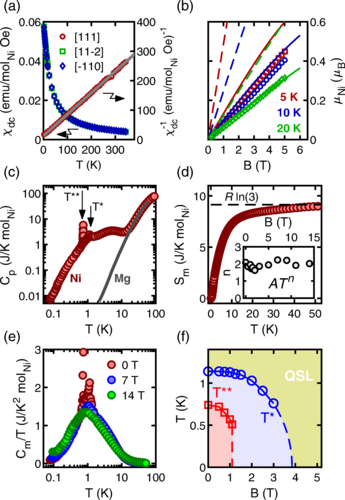
Experimental and theoretical delimitation of the quasi-1D Tomonaga-Luttinger-liquid regime in a spin-1 field-induced antiferromagnet. Journal of Alloys and Compounds.
Through a combination of experimental and theoretical techniques, we study the spin-1 field-induced antiferromagnet NiCl2-4SC(NH2)2, (DTN). Specifically, we use magnetic susceptibility and specific heat measurements, combined with Quantum Monte-Carlo calculations to delimit the quasi-1D Tomonaga-Luttinger-liquid region just above the BEC phase diagram and extend our studies to higher temperatures, where the spin interactions become negligible. This also allows us to verify some discrepancies in the value of the single-ion anisotropy parameter D, which are not well understood yet.
J. Alloys Compd. 853, 157346 (2021)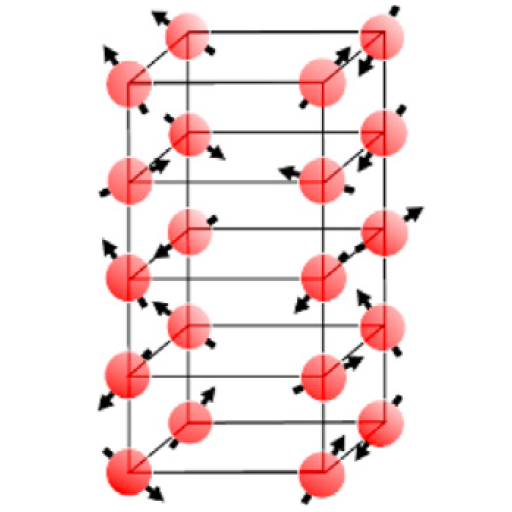
Other recent publications*
Urea decomposition mechanism by dinuclear nickel complexes Molecules, 28(4), 1659 (2023)
Selective CO2 adsorption at low pressure in nitrogen‐rich copper(II) coordination polymers ChemistrySelect 7, Issue 31 (2022)
Crystalline and magnetic properties of CoO nanoparticles locally investigated by using radioactive indium tracer Scientific Reports 11, 21028 (2021)
Local inspection of magnetic properties in GdMnIn by measuring hyperfine interactions AIP Advances 11, 015322 (2021)
High-saturation magnetization in small nanoparticles of Fe3O4 coated with natural oils Journal of Nanoparticle Research 22, 68 (2020)
An inelastic neutron scattering, Raman, far-infrared, and molecular dynamics study of the intermolecular dynamics of two ionic liquids Phys. Chem. Chem. Phys. 22, 9074-9085 (2020)
* Until November 6, 2023.
